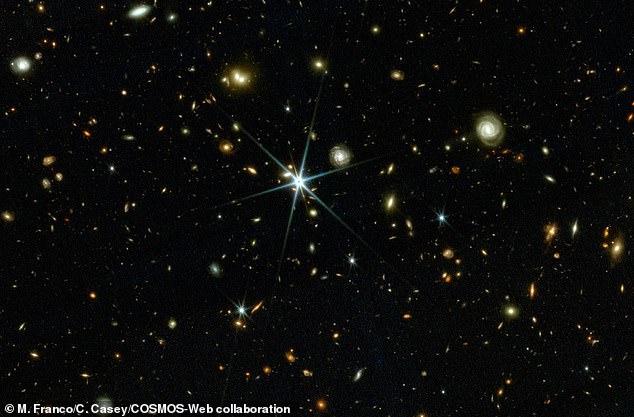[ad_1]
Studying the depths of the universe usually involves billions of pounds of supercomputers, satellites, and telescopes.
But a team of scientists has now made it possible for you to explore the cosmos from the comfort of your own home.
Their incredible interactive map, dubbed COSMOS-Web, lets you scroll through almost 800,000 galaxies and peer back as far as 13.5 billion years.
That means looking back through 98 per cent of cosmic time almost to the birth of the universe 13.8 billion years ago.
Covering an area of sky about the same size as three full moons, this image combines more than 10,000 photographs from the James Webb Space Telescope.
Professor Caitlin Casey, an astronomer at UC Santa Barbara who co-led the COSMOS collaboration, said: ‘Our goal was to construct this deep field of space on a physical scale that far exceeded anything that had been done before.
‘If you had a printout of the Hubble Ultra Deep Field on a standard piece of paper, our image would be slightly larger than a 13-foot by 13-foot-wide mural, at the same depth.
‘So it’s really strikingly large.’

Scientists have created an incredible interactive map of the universe, allowing you to scroll through over 800,000 galaxies

The COSMOS-Web map combines over 10,000 images from the James Webb Space Telescope to create the largest deep-field map of the universe ever created. This image shows how much detail can be revealed as you zoom in
While the data for this map has existed for a while, it was previously in a raw form that needed expert analysis and a supercomputer to interpret.
But over the last two years, an international team of scientists has worked to turn the data behind the largest map of the universe into something that anyone can use.
In the stunning interactive map, at this link, you can zoom out to see hundreds of thousands of galaxies stretch across the sky or zoom in to reveal amazing details.
Using the tools included in the map you can even dive deeper into the data by switching between different imaging tools.
To learn even more, turn on catalogues using the tabs on the left-hand side and click on any galaxy to bring up a vast trove of data.
The researchers have made this available to the public in the hopes that more people will be able to help dig into the data and unpick some of the universe’s most puzzling questions.
Professor Casey says: ‘The best science is really done when everyone thinks about the same data set differently.
‘It’s not just for one group of people to figure out the mysteries.’

Six galaxies hidden in the COSMOS-Web map as they were 3 billion, 4 billion, 8 billion, 9 billion and 10 billion years ago (from top left to bottom right). This period spans almost the entirety of cosmic history

Nine galaxies in the map which span all of cosmic time, from upper left to lower right: the present day universe, 3, 4, 8, 9, 10, 11, 12 and 13 billion years ago
Already, this enormous set of data is helping scientists understand how galaxies formed at the beginning of time and challenging some basic assumptions in astronomy.
Based on data from the Hubble Space Telescope, astronomers expected galaxies to be extremely rare in the first 500 million years.
This is because it takes a long time for stars to form under gravity and get pulled together into larger structures.
But when the researchers looked back at the most distant reaches of the universe, they found there were about 10 times more galaxies than they expected to find.
Professor Casey says: ‘Since the telescope turned on we’ve been wondering ‘Are these JWST datasets breaking the cosmological model?’
‘Because the universe was producing too much light too early; it had only about 400 million years to form something like a billion solar masses of stars. We just do not know how to make that happen.’
The map is so much more detailed than earlier efforts because of the size of the James Webb Space Telescope (JWST).
While Hubble’s main light-collecting was 7ft 10 inches (2.4m) across, the JWST’s is a staggering 21ft (6.5m) wide.

An international team of scientists have spent the last two years converting the raw data of the map into something that anyone can access

You can use the filters on the map to reveal more information about the universe

By clicking on any galaxy you can pull up a huge amount of data collected by the James Webb Space Telescope
That allows the telescope to collect the faintest traces of light coming from the furthest reaches of the galaxy.
Dr Jeyhan Kartaltepe, associate professor at the Rochester Institute of Technology who co-leads COSMOS-Web, says: ‘The sensitivity of JWST lets us see much fainter and more distant galaxies than ever before, so we’re able to find galaxies in the very early universe and study their properties in detail.’
Going forward the team behind COSMOS-Web still has a lot more work to do in order to unpack all the data hidden in the map.
They plan to use the JWST spectrographic tools to identify the oldest galaxies in the image and learn more about the chemistry of these early stars.
[ad_2]
This article was originally published by a www.dailymail.co.uk . Read the Original article here. .


